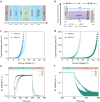Stable pure-green organic light-emitting diodes toward Rec.2020 standard
- PMID: 38782957
- PMCID: PMC11116534
- DOI: 10.1038/s41467-024-48659-6
Stable pure-green organic light-emitting diodes toward Rec.2020 standard
Abstract
Manipulating dynamic behaviours of charge carriers and excitons in organic light-emitting diodes (OLEDs) is essential to simultaneously achieve high colour purity and superior operational lifetime. In this work, a comprehensive transient electroluminescence investigation reveals that incorporating a thermally activated delayed fluorescence assistant molecule with a deep lowest unoccupied molecular orbital into a bipolar host matrix effectively traps the injected electrons. Meanwhile, the behaviours of hole injection and transport are still dominantly governed by host molecules. Thus, the recombination zone notably shifts toward the interface between the emissive layer (EML) and the electron-transporting layer (ETL). To mitigate the interfacial carrier accumulation and exciton quenching, this bipolar host matrix could serve as a non-barrier functional spacer between EML/ETL, enabling the distribution of recombination zone away from this interface. Consequently, the optimized OLED exhibits a low driving voltage, promising device stability (95% of the initial luminance of 1000 cd m-2, LT95 > 430 h), and a high Commission Internationale de L'Éclairage y coordinate of 0.69. This indicates that managing the excitons through rational energy level alignment holds the potential for simultaneously satisfying Rec.2020 standard and achieving commercial-level stability.
© 2024. The Author(s).
Conflict of interest statement
The authors declare no competing interests.
Figures





References
-
- Cai X, Su S-J. Marching toward highly efficient, pure-blue, and stable thermally activated delayed fluorescent organic light-emitting diodes. Adv. Funct. Mater. 2018;28:1802558. doi: 10.1002/adfm.201802558. - DOI
-
- Chan C-Y, et al. Stable pure-blue hyperfluorescence organic light-emitting diodes with high-efficiency and narrow emission. Nat. Photonics. 2021;15:203–207. doi: 10.1038/s41566-020-00745-z. - DOI
-
- Zhou D, et al. Stable Tetradentate Gold(III)-TADF emitters with close to unity quantum yield and radiative decay rate constant of up to 2 × 106 s−1: high-efficiency green OLEDs with operational lifetime (LT90) longer than 1800 h at 1000 cd m−2. Adv. Mater. 2022;34:2206598. doi: 10.1002/adma.202206598. - DOI - PubMed
Grants and funding
LinkOut - more resources
Full Text Sources

